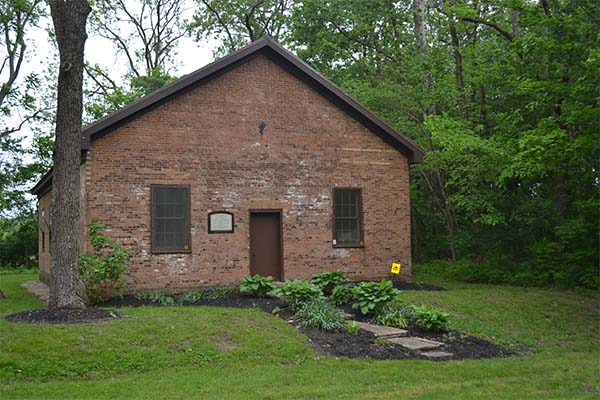The above old church building was for Indian Creek Regular Baptist Church near the house where I lived from 1968 through 1973 with my mother and step father and siblings. It is located in Butler county Ohio near a little town called "Reily." When I became a "Primitive Baptist" at 16 years old, my father took me out to this historic old building. He said it was once "one of their churches," and that Elder Gilbert Beebe made a trip in the area during the time of the division over missions and theological education and preached at this church. It was also once pastored by Elder Wilson Thompson, one of the big leaders in the newly formed "Old School" or "Primitive Baptist" denomination.
In those days I used to visit this old church building, walk in the cemetery and notice the dates and names on the headstones, go into the pulpit, etc. I would envision the people as they assembled here in the early to mid 19th century. It is interesting to me now, looking back, how early on I was interested in "Primitive Baptist" history. I remember how I researched the history of the Baptists in the northwest territory, including Ohio and Indiana, two of three states most connected with my ancestry. Butler county adjoined Indiana. I also used to find old small graves out in the woods around Reily and some had dates going back to the 1700s before Ohio became a state in 1803. I researched the history of Indian Creek church.
I visited an older couple not far from where I lived who were in charge of the building and grounds for the Parks and Recreation or the Historical Society, I can't remember which. They knew a lot about the history of the church. They were Presbyterians and I can recall the old woman saying to me (I had not been a Christian very long) "I am in the land of Canaan." I don't know why this has stuck with me, but if she were here now I would say "so am I, hallelujah."
I also in my studies for that area of Ohio and Indiana discovered that there were several "Universalist" church buildings that were also abandoned and under the care of historical societies. So, I have always had an interest in history. In fact I loved all the social sciences in High School and college. Now let me give some citations concerning the history of this church.
"The Indian Creek Pioneer Church and Burial Ground includes a cemetery, established in 1810 that served as final resting place for the area's earliest settlers and a brick meeting house, circa 1829." (here)
"Indian Creek Baptist Church was organized in 1810 three miles above Reily, Since 1860 there have been no regular services in the church."
"The Indian Creek Regular Baptist Church was established in 1810 as an arm of the Little Cedar Creek Church of Brookville, Indiana. The congregation purchased three acres of land for a burial ground and church and built a log structure here in 1811. Members voted in 1812 that they would receive no person who believed in the principles of slavery. By 1829, membership had reached 150 and the present brick meeting house was built. In the 1840s, membership declined due to conflict over mission activity. The congregation dissolved in 1879 and the land was deeded to the Indian Creek Cemetery Association in 1880. The county park system received the property in 1960 through and with the cooperation of the Butler County Historical Society and the Cemetery Association." (See here)
What a tragedy!
"Two itinerant Baptist preachers, famous for their work in the early days of the North West Territory served this church well. Elder William Tyner of Brookville, Indiana, a man "of rare worth and a natural born orator" moderated the first meeting of the Church in the cabin of John Morris. That July day Elder Tyner rode horse-back through the dense forest up along the White Water River to the mouth of Big Cedar Creek up that creek, across a divide to Indian Creek. While Elder Tyner was watering his horse in Big Cedar Creek, he saw an Indian with drawn bow on opposite bank, with arrow pointed at Tyner's heart. Elder Tyner stared "for an eternity" before the Indian lowered his bow andmelted into the forest. Elder Thompson living near Lebanon, Ohio moderated many meetings; the most famous one being in early 1829 when the congregation voted to build the present brick meeting house. Elder Thompson was riding home with his family after burying his father in Indian Creek Cemetery, when his horse was swept away by the flood waters of the swollen Big Miami River." (here)
There is no doubt that Elder Thompson had his hand in splitting this church and forcing its closing. He also did the same in other churches. What an infamy! What an epitaph!

No comments:
Post a Comment